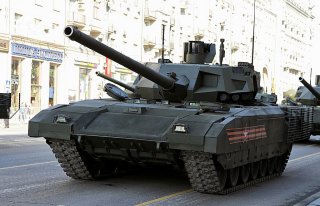Russia’s T-14 Armata Tank: The U.S. Military's Worst Nightmare?
A hotcars.com report makes a number of comparative claims without addressing, incorporating or even discussing the available details about Abrams modernization.
There is a lot of information available about the various technologies and attributes built into Russia’s T-14 Armata tank regarding key features such as weight, speed, fuel efficiency, power, active protection and weaponry.
A report from hotcars.com says the T-14 has a greater range than the Abrams main battle tank because it can operate at ranges of 310 miles, compared with what the article claims as a 265 mile range for the Abrams tank. This range difference, if true, may not amount to much, especially if unmanned robots can deliver fuel to forward positions on the battlefield. Also, the hotcars.com report draws unverified conclusions about weapons comparisons between the Armata and Western tanks.
“The T-14 sports the all-new 2A82-1M 125 mm (4.92 in) smoothbore cannon, replacing the older 2A46 125 mm gun of previous Russian and Soviet tanks. This cannon is more powerful than its Western counterparts like the German Leopard 2's Rheinmetall 120 mm gun,” the report says.
Perhaps of greatest significance, the hotcars.com report makes a number of comparative claims without addressing, incorporating or even discussing the available details about Abrams modernization, facts which bear prominent upon any comparative discussion. Newer variants of the Abrams tank, for example will include new laser rangefinder technology, color cameras, integrated onboard networks, new slip-rings, advanced meteorological sensors, ammunition data links, laser +warning receivers and a far more lethal, multi-purpose 120-millimeter tank round, senior Army weapons developers have explained. The hotcars.com report makes a case for T-14 weapons superiority but also fails to recognize or include that, in terms of weaponry, the Abrams 120-millimeter cannon has not only been upgraded but will fire a multi-purpose ammunition round able to fire High Explosive anti-tank rounds as well as canister rounds, among others. Upgraded Abrams tanks also have an ammunition data link, advanced targeting systems, and programmable fuses.
Other elements of the Abrams left out of the hotcars.com report include the incorporation of advanced computing, electronics, targeting technologies and auxiliary power units able to redefine combat operations moving into the future. The rapid advances in autonomy and manned-unmanned teaming are also left out of the discussion, factors of clear relevance when it comes to an article citing ten-reasons why the Armata is superior than an Abrams. U.S. Army Futures Command, for example, is fast making progress with new robotic vehicles of various weights and configurations increasingly capable of operating with higher degrees of autonomy and networking technologies such that they can operate forward and perform reconnaissance missions, targeting and possibly even attack missions with manned Abrams tank operating in a command and control capacity.
Also, the Abram tank’s advanced forward-looking infrared sensor (FLIR) package uses higher resolution and digital imaging along with an increased ability to detect enemy signatures at farther ranges through various obscurants such as rain, dust or fog, Army officials said. Improved FLIR technologies help tank crews better recognize light and heat signatures emerging from targets such as enemy sensors, electronic signals or enemy vehicles. This enhancement provides an additional asset to a tank commander’s independent thermal viewer. Thermal targeting sights, as demonstrated during now famous Gulf War tank battles, including Abrams tanks against Russian-built T-72, can create range mismatches enabling tanks to destroy enemy tanks without being seen.
Kris Osborn is the defense editor for the National Interest. Osborn previously served at the Pentagon as a Highly Qualified Expert with the Office of the Assistant Secretary of the Army—Acquisition, Logistics & Technology. Osborn has also worked as an anchor and on-air military specialist at national TV networks. He has appeared as a guest military expert on Fox News, MSNBC, The Military Channel, and The History Channel. He also has a Master's Degree in Comparative Literature from Columbia University.
Image: Reuters.

